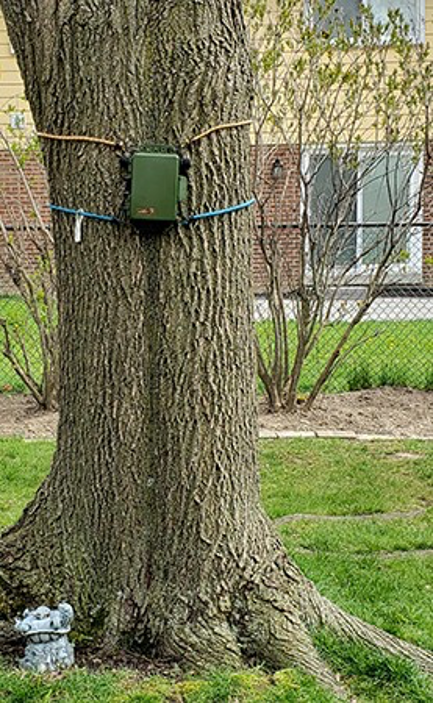Glendon Campus biology students need to learn fieldwork techniques, pandemic, or no pandemic, so Laura McKinnon decided to send them out into their backyards to practice.
Usually, McKinnon teaches this mandatory course, “Ecological Monitoring in an Urban Environment,” as a 12-day intensive course as part of the Ontario Universities Program in Field Biology. Students normally band birds, search for killdeer nests and visit a turtle marking program, along with other activities conducted throughout the extensive Toronto ravine system.

Photo credit: S. Nichols
“For most, it’s their first introduction to research and they get a taste of what it’s all about,” said McKinnon, an associate professor in the bilingual biology program. “Afterward, many of the students decide to pursue it.”
Given the pandemic lockdown, McKinnon moved the course to the spring, but soon discovered that it would still need to be conducted remotely. Determined to ensure that the students would be able to acquire the field skills necessary for any biologist, McKinnon quickly pivoted and created an online course where research took place in each individual student’s backyard. (The photos here were first published in the journal, Academic Practice in Ecology and Evolution, along with McKinnon’s paper on this pivot.)
To lend the equipment necessary for fieldwork to each student in the course, McKinnon restricted the course to 10 students, rather than the usual 20; ensured that each student had a safe greenspace to use; and had the students come to collect their field kits, which included binoculars, a field notebook, field guides, a Burlese funnel, a dissecting scope and bioacoustic monitors.
The course took place over two weeks, with a research paper submitted afterward. McKinnon devoted the first week of the course to teaching the students the techniques they would need to conduct research in their own backyards – tasks such a learning to take proper field notes, identifying birds and conducting a point count of birds in the yard. She also held separate sessions on scientific writing, bioacoustics monitoring (for bird calls/songs and bats), and statistics. The second week of the course was devoted to the research itself. In addition to the investigations the students carried out, pairs of students worked on a research project together.
The course kept students busy. They were up at dawn to conduct backyard point counts of their birds seen or heard and did so again at dusk. At 8 a.m., the class met online to share their morning findings and discuss other issues and activities; in fact, they usually were on Zoom together a few times daily.
During the day, the students also dug pitfall traps for insects and collected a turf sample to use in the Burlese funnels, identifying these insects afterward. In addition, they set up camera traps in an attempt to photograph wildlife wandering the property. They were required to do habitat sampling, describing their individual urban habitat in detail, which required them to measure tree height and estimate and describe ground cover.

Photo credit: M. Jurj
“Having mastered sampling techniques in the fields of ornithology, mammalogy, entomology and botany, each student became the principal investigator of their own field site, individually collecting data according to standard ecological protocols, and contributing these data to the larger network of eight field sites across Toronto,” McKinnon said. “That these field sites were the students’ backyards, did not detract from their ability to conduct scientific research projects on fundamental ecological questions in urban ecology.”
The students were also responsible for entering their data into a joint folder so that everyone in the class had access to the overall data to use for their research projects. Each group decided upon a research project and wrote a research proposal, consisting of the introduction and methods section that journal articles require, based on the data they had at their disposal. Once McKinnon provided feedback, each group prepared the outline of a research paper, including a results section. Finally, every individual student was required to submit the actual research paper, incorporating McKinnon’s comments, and adding a discussion section.
“In discussing their results, the students can draw upon the theories they’ve learned about in their ecology courses,” McKinnon said. “Although their findings are on a small scale and can’t actually be published, there were some good ideas to pursue.”
For example, one team of students measured minimum and maximum call frequencies (Hz) of American Robins at sunrise and sunset using bioacoustics recorders deployed in the backyard sites over the 10-day period of data collection. Using the same recorders, they simultaneously measured ambient levels of anthropogenic noise. They then tested whether the birds changed the frequency of their calls to compensate for increased anthropogenic noise in busier urban areas.
McKinnon received positive feedback from her students and is confident they had a well-rounded field experience and acquired the necessary field research skills used by biologists.
“An online field course that incorporates direct experience with the natural environment is possible and should no longer be considered an oxymoron,” said McKinnon.
By Elaine Smith, special contributing writer, Innovatus

